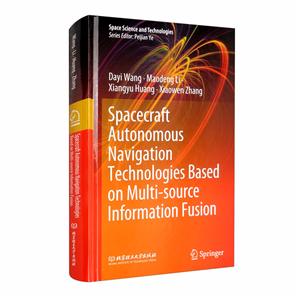-
>
湖南省志(1978-2002)?铁路志
-
>
公路车宝典(ZINN的公路车维修与保养秘籍)
-
>
晶体管电路设计(下)
-
>
基于个性化设计策略的智能交通系统关键技术
-
>
德国克虏伯与晚清火:贸易与仿制模式下的技术转移
-
>
花样百出:贵州少数民族图案填色
-
>
识木:全球220种木材图鉴
航天器多源信息融合自主导航技术=Spacecraft Autonomous 版权信息
- ISBN:9787568290081
- 条形码:9787568290081 ; 978-7-5682-9008-1
- 装帧:一般胶版纸
- 册数:暂无
- 重量:暂无
- 所属分类:>
航天器多源信息融合自主导航技术=Spacecraft Autonomous 内容简介
This book introduces readers to the fundamentals of estimation and dynamical system theory, and their applications in the field of multi-source information fused autonomous navigation for spacecraft. The content is divided into two parts: theory and application. The theory part (Part I) covers the mathematical background of navigation algorithm design, including parameter and state estimate methods, linear fusion, centralized and distributed fusion, observability analysis, Monte Carlo technology, and linear covariance analysis. In turn, the application part (Part II) focuses on autonomous navigation algorithm design for different phases of deep space missions, which involves multiple sensors, such as inertial measurement units, optical image sensors, and pulsar detectors. By concentrating on the relationships between estimation theory and autonomous navigation systems for spacecraft, the book bridges the gap between theory and practice. A wealth of helpful formulas and various types of estimators are also included to help readers grasp basic estimation concepts and offer them a ready reference guide.
航天器多源信息融合自主导航技术=Spacecraft Autonomous 目录
1.1 Autonomous Navigation Technology
1.1.1 Inertial Navigation
1.1.2 Autonomous Optical Navigation
1.1.3 Autonomous Pulsar-Based Navigation
1.2 Multi-source Information Fusion Technology
1.2.1 Definition of Multi-source Information Fusion
1.2.2 Classification of Multi-source Information Fusion Technologies
1.2.3 Multi-source Information Fusion Methods
1.3 Autonomous Navigation Technology Based on Multi-source Information Fusion
1.3.1 Research and Application Progress
1.3.2 Necessity and Advantages
1.4 Outline
References
2 Point Estimation Theory
2.1 Basic Concepts
2.2 Common Parameter Estimators
2.2.1 MMSE Estimation
2.2.2 ML Estimator
2.2.3 Maximum a Posteriori (MAP) Estimator
2.2.4 Weight Least-Square (WLS) Estimator
2.3 Closed Form Parameter Estimators
2.3.1 Linear Estimator
2.3.2 MMSE Estimator for Jointly Gaussian Distribution
2.3.3 Estimation Algorithms for Linear Measurement Equation
2.4 State Estimation Algorithms in Dynamic Systems
2.4.1 Recursive Bayesian Estimation
2.4.2 Kalman Filtering
2.4.3 Extended Kalman Filtering
2.4.4 Unscented Kalman Filtering
2.4.5 Constrained Kalman Filtering
2.5 Brief Summary
References
……
3 Estimation Fusion Algorithm
4 Performance Analysis
5 Time and Coordinate Systems
6 Dynanuc Models and Environment Models
7 Inertial Autonomous Navigation Technology
8 Optical Autonomous Navigation Technology
9 Optical/Pulsar Integrated Autonomous Navigation Technology
10 Altimeter and Velocimeter-/Optical-Aided Inertial Navigation Technology
11 Simulation Testing Techniques for Autonomous Navigation Based on Multi-source Information Fusion
12 Prospect for Multi-source Information Fusion Navigation
Appendix
航天器多源信息融合自主导航技术=Spacecraft Autonomous 作者简介
王大轶,研究员,现任中国空间技术研究院总体部副部长,中国宇航学会英文刊Advances in Astronautics Science and Technology(《航天科技前沿》)编委,国家杰出青年科学基金获得者,国防科技卓越青年科学基金获得者,国家万人计划科技创新领军人才,“973项目”技术首席专家。在航天器自主导航与控制领域进行创新研究工作,解决了一系列关键技术问题,为嫦娥月球探测器等型号飞行试验成功做出了贡献。2016年获何梁何利基金科学与技术创新奖,2017年入选***百千万人才工程,是国务院政府特殊津贴专家、国家有突出贡献中青年专家。获国家技术发明二等奖1项,部级一等奖4项、二等奖4项。
- >
随园食单
随园食单
¥21.6¥48.0 - >
罗庸西南联大授课录
罗庸西南联大授课录
¥13.8¥32.0 - >
人文阅读与收藏·良友文学丛书:一天的工作
人文阅读与收藏·良友文学丛书:一天的工作
¥14.7¥45.8 - >
我与地坛
我与地坛
¥15.4¥28.0 - >
大红狗在马戏团-大红狗克里弗-助人
大红狗在马戏团-大红狗克里弗-助人
¥3.5¥10.0 - >
苦雨斋序跋文-周作人自编集
苦雨斋序跋文-周作人自编集
¥6.9¥16.0 - >
上帝之肋:男人的真实旅程
上帝之肋:男人的真实旅程
¥30.5¥35.0 - >
莉莉和章鱼
莉莉和章鱼
¥19.7¥42.0
-
迷蒙星空-探天之路
¥14.5¥39 -
飞天起航
¥13.9¥35 -
航空工业出版社遥控模型飞机系列遥控像真模型飞机入门
¥20.2¥48 -
航天器自主导航技术
¥39.1¥112 -
国家出版基金 中国航天的历史使命
¥22.8¥68 -
航空超高强度钢的发展
¥25.9¥58




















